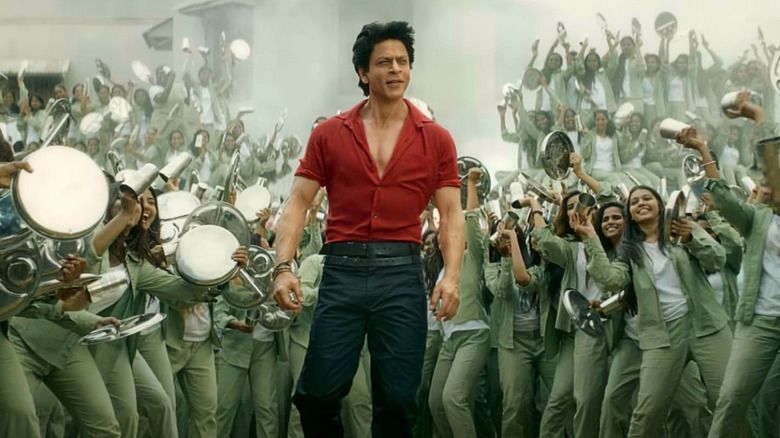How Jawan Became One Of 2023's Biggest Box Office Success Stories (And What Comes Next For Indian Cinema)
After theaters re-opened en masse in early 2021 in the wake of early pandemic closures, theater owners have been searching for new ways to get moviegoers back. Yes, big blockbusters such as "Avatar: The Way of Water" and "Barbie" fill seats, but what about in between those massive tentpoles? There is some evidence to suggest that Indian films could be a bigger part of the equation moving forward. We can and should look at the recent success of "Jawan" as evidence of that.
The Hindi-language Bollywood blockbuster opened in North America and throughout much of the world in early September. It was a big deal, as it marked the return of Indian megastar Shah Rukh Khan, who had already set the box office on fire earlier this year with the massive hit "Pathaan" ($128.7 million worldwide). That movie ranks as one of the biggest Hindi hits of all time. Well, "Jawan" has since emerged as an even bigger hit, both in India and throughout the world.
There's no need to go over the exhaustive number of records that director Atlee's "Jawan" has broken, but let's take a look at the big picture. The film, which is described as a "high-octane action thriller which outlines the emotional journey of a man who is set to rectify the wrongs in society," has earned more than $135 million worldwide, including just shy of $15 million domestically. It ranks as the fifth-biggest Indian movie in history, and the biggest Bollywood movie ever, unadjusted for inflation. It is also the biggest Hindi movie ever.
It's important to point out that Rukh Khan is incredibly famous in India and, after a five-year break from acting, his return with two different movies this year has been met with feverish excitement. That's paramount. But a part of this movie's global success is owed to American audiences showing up in a meaningful way.
Jawan isn't an isolated incident
Looking at the slightly larger picture here, it appears "Jawan" isn't an outlier. Other recent Indian blockbusters have reliably found an audience in the US, which didn't used to happen with regularity. As mentioned, "Pathaan" was also a big winner domestically earlier this year, with the action flick taking in $17.5 million of its $128.7 million global total stateside. That's nearly 14% of its worldwide haul.
The bigger story of the last year was "RRR," director S.S. Rajamouli's Indian epic that took the world by storm in 2022. Starring Jr. NTR and Ram Charan, the film became an absolute sensation, and despite its hulking three-hour runtime and minimal advertising in the States, it managed to make more than $15 million domestically. That represents about 9% of the movie's sizable $166.6 million total. The film even won an Oscar for Best Original Song, with "Naatu Naatu" taking home the coveted prize during Hollywood's biggest night. It's easy to imagine that a sequel, if one actually happens, will make even more in the US as a result.
Within the span of a calendar year and change, we've had three Indian films make meaningful money in North America. What's perhaps most impressive is that much of this is being driven by word-of-mouth, as it's not as though massive marketing campaigns are being executed for these movies in the US. Moviegoers are seeking this stuff out, much in the same way that a sizable number of people have flocked to anime in theaters in recent years. The audience is there, and the audience is finding what they're looking for.
Breaking through in North America
The fact of the matter is, at a time with so much uncertainty in the theatrical landscape — and the larger media landscape in general — anything that can help get people enthusiastically out to theaters is welcome. These Indian blockbusters are doing precisely that. The hope is that more Indian films can continue to do the same and, ideally, reach even larger audiences as time rolls on, creating a snowball effect that would benefit multiple parties.
To do that, though, may require more than just word of mouth as it currently exists. What might be a big step in the right direction is making sure that these movies are readily available after their theatrical runs on major streaming services such as Netflix, as well as physical media. "RRR" was streaming on Netflix, which is good, but it wasn't presented in its original Telugu language. That was far from ideal. The movie has also not received an official physical media release. Also not ideal.
Making sure that audiences can discover movies like "Jawan" after their theatrical runs is crucial. Discoverability is key. If someone stumbles upon "Jawan" on Paramount+, for example, and they enjoy it, they might be more likely to see Shah Rukh Khan's next movie in theaters. That's a best-case scenario. At the very least, seeing more Indian films showcased regularly at major theater chains would be a good start. Here's hoping these recent movies are the start of a trend rather than a short-lived flame that burns brightly but extinguishes quickly.


